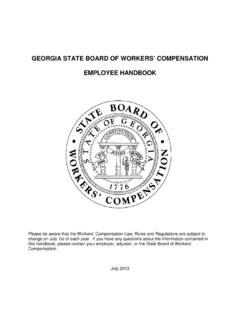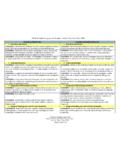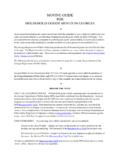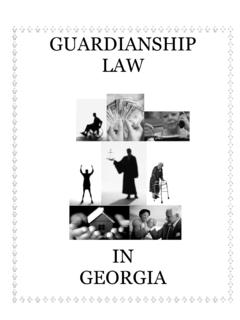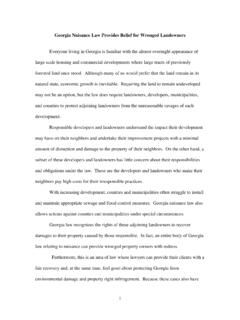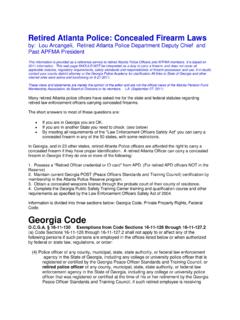Transcription of Grade Three - Georgia Standards
1 One Stop Shop For Educators Georgia Department of Education Kathy Cox, State Superintendent of Schools social studies Grade Three Standards APPROVED 10/14/2004 REVISED 8/14/2008 Page 1 of 5 Copyright 2008 All Rights Reserved Grade Three OUR DEMOCRATIC HERITAGE In third Grade , students conclude their introduction to United States history by studying the origins of American democracy. The historical strand compares ancient Greek democracy in Athens with that of the United States, and introduces selected Americans who have been important in ensuring our rights. The geography strand relates primarily to the people discussed in the history strand. In the government strand, students begin the study of the foundations of a republican form of government.
2 The economics strand continues the introduction of basic economics concepts. Historical Understandings SS3H1 The student will explain the political roots of our modern democracy in the United States of America. a. Identify the influence of Greek architecture (columns on the Parthenon, U. S. Supreme Court building), law, and the Olympic Games on the present. b. Explain the ancient Athenians idea that a community should choose its own leaders. c. Compare and contrast Athens as a direct democracy with the United States as a representative democracy. SS3H2 The student will discuss the lives of Americans who expanded people s rights and freedoms in a democracy. a.
3 Paul Revere (independence), Frederick Douglass (civil rights), Susan B. Anthony (women s rights), Mary McLeod Bethune (education), Franklin D. Roosevelt (New Deal and World War II), Eleanor Roosevelt (United Nations and human rights), Thurgood Marshall (civil rights), Lyndon B. Johnson (Great Society and voting rights), and C sar Ch vez (workers rights). b. Explain social barriers, restrictions, and obstacles that these historical figures had to overcome and describe how they overcame them. Geographic Understandings SS3G1 The student will locate major topographical features. a. Identify major rivers of the United States of America: Mississippi, Ohio, Rio Grande, Colorado, Hudson.
4 B. Identify major mountain ranges of the United States of America: Appalachian, Rocky. c. Locate the Equator, Prime Meridian, and lines of latitude and longitude on a globe. d. Locate Greece on a world map. One Stop Shop For Educators Georgia Department of Education Kathy Cox, State Superintendent of Schools social studies Grade Three Standards APPROVED 10/14/2004 REVISED 8/14/2008 Page 2 of 5 Copyright 2008 All Rights Reserved SS3G2 The student will describe the cultural and geographic systems associated with the historical figures in SS3H2a. a. Identify on a political map specific locations significant to the life and times of these historical figures.
5 B. Describe how place (physical and human characteristics) had an impact on the lives of these historical figures. c. Describe how each of these historical figures adapted to and was influenced by his/her environment. d. Trace examples of travel and movement of these historical figures and their ideas across time. e. Describe how the regions in which these historical figures lived affected their lives and had an impact on their cultural identification. Government/Civic Understandings SS3CG1 The student will explain the importance of the basic principles that provide the foundation of a republican form of government. a. Explain why in the United States there is a separation of power between branches of government and levels of government.
6 B. Name the Three levels of government (national, state, local) and the Three branches in each (executive, legislative, judicial), including the names of the legislative branch (Congress, General Assembly, county commission or city council). c. State an example of the responsibilities of each level and branch of government. SS3CG2 The student will discuss the character of different historical figures in SS3H2a. a. Describe how the different historical figures in SS3H2a display positive character traits of cooperation, diligence, courage, and leadership. b. Explain how the historical figures in SS3H2a used positive character traits to support their beliefs in liberty, justice, tolerance, and freedom of conscience and expression.
7 C. Explain how the historical figures in SS3H2a chose when to respect and accept authority. Economic Understandings SS3E1 The student will describe the four types of productive resources: a. Natural (land) b. Human (labor) c. Capital (capital goods) d. Entrepreneurship (used to create goods and services) SS3E2 The student will explain that governments provide certain types of goods and services in a market economy, and pay for these through taxes and will describe services such as schools, libraries, roads, police/fire protection, and military. One Stop Shop For Educators Georgia Department of Education Kathy Cox, State Superintendent of Schools social studies Grade Three Standards APPROVED 10/14/2004 REVISED 8/14/2008 Page 3 of 5 Copyright 2008 All Rights Reserved SS3E3 The student will give examples of interdependence and trade and will explain how voluntary exchange benefits both parties.
8 A. Describe the interdependence of consumers and producers of goods and services. b. Describe how goods and services are allocated by price in the marketplace. c. Explain that some things are made locally, some elsewhere in the country, and some in other countries. d. Explain that most countries create their own currency for use as money. SS3E4 The student will describe the costs and benefits of personal spending and saving choices. One Stop Shop For Educators Georgia Department of Education Kathy Cox, State Superintendent of Schools social studies Grade Three Standards APPROVED 10/14/2004 REVISED 8/14/2008 Page 4 of 5 Copyright 2008 All Rights Reserved social studies Skills Matrices MAP AND GLOBE SKILLS GOAL: The student will use maps to retrieve social studies information.
9 I: indicates when a skill is introduced in the Standards and elements as part of the content D: indicates Grade levels where the teacher must develop that skill using the appropriate content M: indicates Grade level by which student should achieve mastery, the ability to use the skill in all situations A: indicates Grade levels where students will continue to apply and improve mastered skills Map and Globe Skills K 1 2 3 4 5 6 7 8 9-12 1. use cardinal directions I M A A A A A A A A 2. use intermediate directions I M A A A A A A A 3. use a letter/number grid system to determine location I M A A A A A A 4. compare and contrast the categories of natural, cultural, and political features found on maps I M A A A A A A 5.
10 Use inch to inch map scale to determine distance on map I M A A A A A A 6. use map key/legend to acquire information from, historical, physical, political, resource, product and economic maps I D M A A A A A 7. use a map to explain impact of geography on historical and current events I D M A A A A A 8. draw conclusions and make generalizations based on information from maps I M A A A A A 9. use latitude and longitude to determine location I D D D M A A 10. use graphic scales to determine distances on a map I M A A A A 11. compare maps of the same place at different points in time and from different perspectives to determine changes, identify trends, and generalize about human activities I M A A A A 12.










